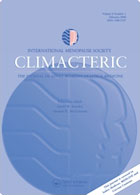Overdiagnosis may further diminish mammographic breast cancer benefits minimized by elegant study

©CLIMACTERIC
The Journal Of the International Menopause Society.
April 2011.
*Also published in © Menopause Live 2010. An e-newsletter of the International Menopause Society.
Winnifred Cutler. Ph.D., Athena Institute for Women's Wellness, Chester Springs, PA.
and
Regula Burki, M.D., Berne, Switzerland
*Please click here for more on pheromones and books from Athena Institute
Date of release: April, 2011
Overdiagnosis may further diminish mammographic breast cancer benefits minimized by elegant study
Many of us take it as a given that mammography reduces mortality from breast cancer. In September, 2010, Kalager and colleagues reported that, with the widespread onset of mammographic screening, there has been a calculable reduction in breast cancer mortality after diagnosis in Norway [1]. This important study shows that the reduction in mortality is not as great as had previously been estimated by the World Health Organization. The authors compared the data from the 1985ˆ1995 historical period to the data from the 1996ˆ2005 recent period, among both screened and unscreened groups. Compared to the historical period, both recent groups experienced a lower mortality after breast cancer diagnosis. Among women 50ˆ69 years old, the rate of death was reduced by 7.2 per 100,000 person-years in the screened group vs. 4.8 in the matched non-screened group. Matching current (screened vs. non-screened) groups to historical groups improves our understanding of the difference between mammogram screenings coupled to improved medical care vs. improvements in care without mammograms. Subtracting the 4.8 rate from the 7.2 rate reduces the benefit of mammogram screening to 2.4 or, as the authors said, two-thirds of this reduction in mortality after breast cancer diagnosis is independent of mammogram screening and is apparently due to improved medical care.
Comment
We believe that one further element needs to be factored into the authors‚ elegant equation: that of overdiagnosis, i.e. the mammographic finding of breast cancers that would never come to medical attention because they either regressed on their own or failed to grow into a problem.
Several recent studies, including some in Norway, have demonstrated that 20ˆ30% of breast cancers found within the first 10 years of screening would never have come to medical attention [2-4]. Published autopsy findings also support the fact that people live with breast cancer without knowing of its existence [4,5]. Apparently, 20ˆ30% of breast cancers either regress or do not grow and never manifest themselves clinically. These, like some prostate cancers, require no treatment.
Using the reduced mortality incidence reported here in the group testing the combination of mammogram with improved medical care (7.2 per 100,000 person-years), we can estimate the impact of either a 20% or a 30% overdiagnosis using simple algebra. If mortality is calculated by dividing the number of deaths by the number of cases, and if there are 20% overdiagnosed cases in the screened vs. the unscreened group, we have a denominator that is 20% too large. In other words, for every 100 women who would be found with breast cancer without mammograms, we are seeing 20 extra overdiagnosed cases thanks to mammograms. By actual proportion, this is [100/120 = 0.833]. Then, the adjusted calculation for the Œmortality rate‚ of the mammogram group should be 0.833; 83.3% of 7.2 = 5.99 deaths per 100,000 women. There is no need to adjust the calculation of the non-screened group because there was no overdiagnosis (due to no screening).
Or if, due to better mammographic equipment, overdiagnosis is as high as 30%, then the appropriate adjustment is 100/130 = 0.769; 76.9% of 7.2 = 5.54 deaths per 100,000 person-years.
So, the adjusted mortality reduction that can be attributed to widespread mammographic screening may be even more modest than reported by Kalager and colleagues: instead of the 7.2 reduction per 100,000 person-years that they report, a number somewhere between 5.99 and 5.54 should be compared to the 4.8 reduction per 100,000 person-years found in non-screened women. Hence, between 80% (4.8/5.99) and 88% (4.8/5.54) of the reduction in mortality may be attributable to issues other than mammogram screening.
Winnifred Cutler
Athena Institute for Women‚s Wellness, Chester Springs, PA, USA
and
Regula Burki
Department of Obstetrics & Gynecology, Salem-Spital, Hirslanden Hospital Group, Berne, Switzerland
References
1. Kalager M, Zelen M, Langmark F, Adami HO. Effect of screening mammography on breast-cancer mortality in Norway. N Engl J Med 2010;363:1203-10.
http://www.ncbi.nlm.nih.gov/pubmed/20860502
2. Zahl PH, Maehlen J, Welch HG. The natural history of invasive breast cancers detected by screening mammography. Arch Intern Med 2008;168:2311-16.
http://www.ncbi.nlm.nih.gov/pubmed/19029493
3. Zackrisson S, Andersson I, Janzon L, Manjer J, Garne JP. Rate of overdiagnosis of breast cancer 15 years after end of Malmo mammographic screening trial: follow-up study. BMJ 2006;332:689-92.
http://www.ncbi.nlm.nih.gov/pubmed/16517548
4. Jorgensen KJ, Gotzche PC. Overdiagnosis in publicly organized mammography screening programmers: systematic review of incidence trends. BMJ 2009 Jul 9;339:b2587.http://www.ncbi.nlm.nih.gov/pubmed/19589821
5. Santen RJ, Allred DC, Ardoin SP, et al. Postmenopausal hormone therapy: an Endocrine Society Supplement: J Clin Endocrinol Metab 2010;95(Suppl 1):S1-66.http://www.ncbi.nlm.nih.gov/pubmed/20566620
*Related book by Dr. Cutler: Hormones and Your Health